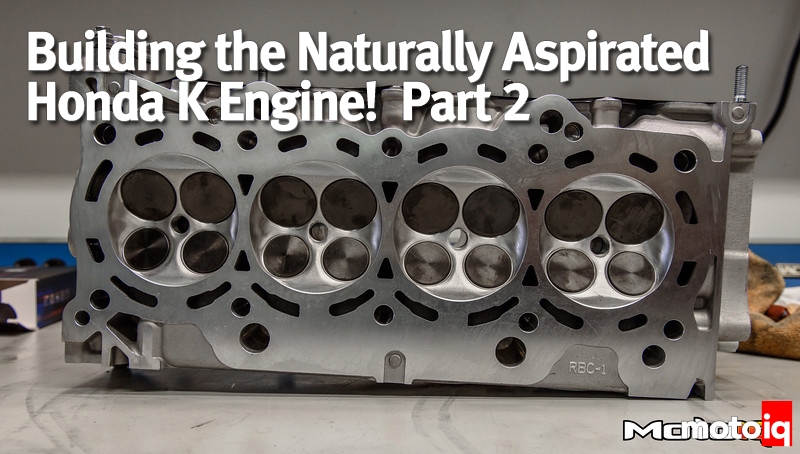
Building the Naturally Aspirated Honda K Engine with Drag Cartel! Part 2
In the last edition of building the naturally aspirated K24, we were showing some of the detail of building a solid dry sumped bottom end for an Ariel Atom track car with a lot of aero. In this edition, we will be getting rid of the K24 Z7's main performance bottleneck.
When first introduced the Honda K engine was a jewel for NA performance buffs. The naturally aspirated K series engines featured some of the highest specific power outputs from any manufacturer. Much of this performance was directly attributed to the free flowing ports of the cylinder head.
When dealing with the K24 Z7, the major roadblock to performance, especially when naturally aspirated, is the cylinder head. The Z7 lost VTEC on the exhaust side of the engine and is hamstrung by a nice restrictive and untuned log manifold conveniently permanently cast into the exhaust side of the head itself. Forget about putting headers on this engine!
All was not lost, we contacted K Series engine specialists, Drag Cartel who came to our rescue with a one stop solution for fixing our engine's cork in the volumetric efficiency curve with one of their complete cylinder head and camshaft packages.
Read Part One Here!
Read Part Two Here!
Read Part 3 Here!
Read Part 4 Here!
 To fix our problems with the Z7's lame cylinder head, we called up K Series specialists Drag Cartel for some advice.
To fix our problems with the Z7's lame cylinder head, we called up K Series specialists Drag Cartel for some advice.Drag Cartel supplied us with one of their K20Z3 or RBC Road Race/Endurance Spec Pro Series cylinder heads. The RBC head originally comes from a 2006-2011 Civic Si. Drag Cartel totally reworks the heads. As you can see here, the combustion chambers of the head have been CNC machined to equalize their volume.
The chambers have been CNC relieved around the valves to reduce shrouding and increase low lift flow. The chambers have also been hand blended after CNC machining for smoothness. After all of the chamber work, the head is then milled to bring the chamber volume back down.
The valve seats are replaced with new steel parts and are treated to a radius valve job that is blended into the combustion chamber and the port. Since our engine is not an extreme maximum power build, we opted to keep the stock size valves so we would not have to worry about valve clash on overlap.
We did opt for flat faced Supertech valves. We used Supertech's 37mm nitrided stainless intake valve. The black nitriding gives an extremely hard, corrosion resistant and slippery surface to the valve stems and seating surfaces. For the exhaust valves, we opted for Supertech's 30mm Inconel valve. Inconel is a very hard, strong, and heat resistant alloy.
 The exhaust ports are CNC-machined to Drag Cartel's own proven port design. After CNC machining, the ports are hand blended for smoothness.
The exhaust ports are CNC-machined to Drag Cartel's own proven port design. After CNC machining, the ports are hand blended for smoothness.The port exits are intentionally left a little smaller than the gasket opening for an anti-reversion step mismatch. This also ensures that the header flange opening will not hang into the port to create flow killing turbulence.
The stock iron valve guides are replaced with new Supertech Manganese Bronze valve guides for smooth action and longer wear, great for our cam that is going to have a much higher lift. You can see how the exhaust valve stems are left at full diameter under the valve head for the best heat transfer. The exhaust valve head has a tuliped profilee which helps low lift exit flow.
 The Drag Cartel intake port is also CNC machined and hand blended. You can see her how the port smoothly blends right into the intake seat.
The Drag Cartel intake port is also CNC machined and hand blended. You can see her how the port smoothly blends right into the intake seat. The K engine intake port is nearly a straight drop down into the cylinder and you can see how this port was made to flow like crazy! Like the exhaust side of the head, Supertech manganese bronze valve guides replace the stock iron parts.
The intake valve features an undercut stem which improves flow substantially. The intake valve has a flat nail head like contour which helps inlet flow at low valve lifts. You can see this in the picture.
The intake ports are slightly larger on the inlet side to provide an anti-reversion step mismatch and to prevent the intake port edge from hanging into the inlet flow path and creating power robbing turbulence.
 For camshafts, we chose Drag Cartel's Stage 4 camshafts. These cams should provide impressive gains over stock while still giving a nice wide powerband for our road racing application.
For camshafts, we chose Drag Cartel's Stage 4 camshafts. These cams should provide impressive gains over stock while still giving a nice wide powerband for our road racing application. The Stage 4 cams are ground on 8620 steel billets using state of the art Birco CNC cam grinding machines that can run smaller grinding wheels to do inverted opening flanks. This is important with the K series roller rockers.
The cams have 14.5mm of lift on the intake side with 275 degrees of duration measured at 0.050″ of lift. The exhaust side has 13.2mm of lift with 272 degrees of duration at 0.050″ of lift.




1 comment
Hello. Great articles and videos. Thanks so much.
Can you tell me how one can check for alve clash if using the cams you suggest together with the 37mm Inlet valves and 31mm (S2000) exhaust valves you suggest ?